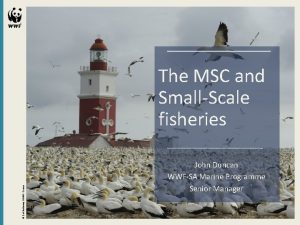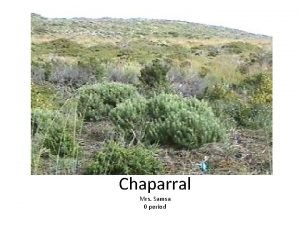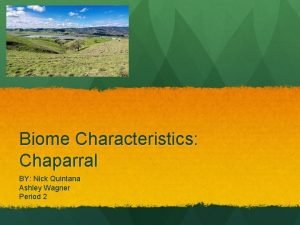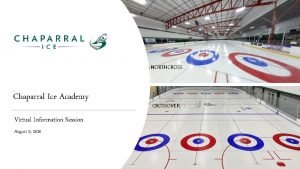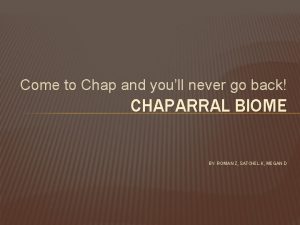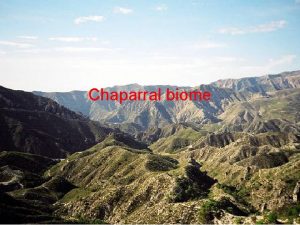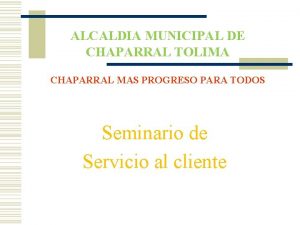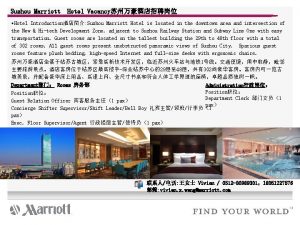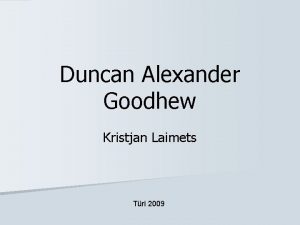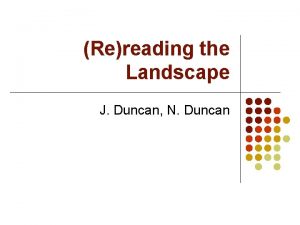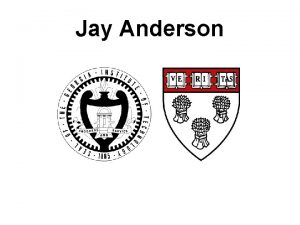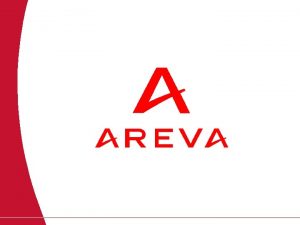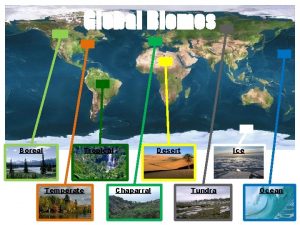Chaparral Physics Research Jay Helmericks Duncan Marriott John




























- Slides: 28

Chaparral Physics Research ▫ Jay Helmericks, Duncan Marriott, John Olson ▫ Wilson Infrasound Observatories ▫ Geophysical Institute, University of Alaska Fairbanks Presented at the Infrasound Technology Workshop Bermuda 3 Nov 2008 This presentation does not necessarily reflect the policies or views of the United States Government.

Abstract This talk will cover two areas of research that Chaparral Physics has been pursuing, both of which are of interest to the general Infrasound community. The first is an investigation of the linearity of Chaparral Physics sensors. The testing shows that there are three regions: with small-amplitude signals the sensor is fully linear; then, as the signal amplitude increases, there is a point where the linearity of the sensor depends on the shape of the incoming wave; and finally, as the signal exceeds 150 Pa peak-to-peak the sensor response completely departs from linearity. The second area of research looks at both the effectiveness and frequency response of wind noise reduction systems, from ~5 Hz to 100 Hz. The effectiveness of wind noise reduction systems have been studied extensively, but little work has been done on the frequency response of such the systems. Preliminary results from this research will be presented. CP Research • ITW 2008 2

Introduction ▫ Linearity of Chaparral Physics sensors ▫ Frequency response of soaker hose ▫ Large area vs small area wind noise reduction systems ▫ New Chaparral Physics sensors CP Research • ITW 2008 3

Linearity Setup ▫ Constructed a test chamber with heavy plywood with a subwoofer as the signal source ▫ Standard audio power amplifier and sound card to drive the speaker ▫ Pressure reference was a G. R. A. S 40 BF ¼” microphone ▫ Able to test from 1 to ~ 200 Hz, and 0. 5 Pa p -p to 700 Pa p-p CP Research • ITW 2008 4

Test Chamber CP Research • ITW 2008 5

Test chamber opened CP Research • ITW 2008 6

Single Tone Test ▫ Drove the chamber with a sine wave of varying frequency and amplitudes ▫ Compared the output of the G. R. A. S. microphone to the Chaparral microphones CP Research • ITW 2008 7

CP Research • ITW 2008 8

100 Pa Fit CP Research • ITW 2008 9

20 Pa Fit CP Research • ITW 2008 10

CP Research • ITW 2008 11

Linearity to 650 Pa p-p CP Research • ITW 2008 12

CP Research • ITW 2008 13

Two Tone Test ▫ Used the same test setup ▫ Ran two sine tones at the same time ▫ A low frequency tone is varied in amplitude ▫ A high frequency tone is constant through the tests ▫ Looked at the amplitude of the high frequency tone as the low frequency tone moves the diaphragm through its operating range CP Research • ITW 2008 14

CP Research • ITW 2008 15

CP Research • ITW 2008 16

CP Research • ITW 2008 17

Linearity Summary ▫ Below 20 Pa p-p non-linearity is not significant ▫ From 20 -150 Pa p-p small scale nonlinearity needs to be considered ▫ Above 150 Pa the wave shape will have significant distortion CP Research • ITW 2008 18

Response of Wind Noise Filters ▫ Measured the frequency response and the noise reduction ▫ 4 50 ft soaker hoses ▫ 2 3 ft soaker hoses ▫ Foam doughnut ▫ Used the same signal source as the linearity tests CP Research • ITW 2008 19

CP Research • ITW 2008 20

CP Research • ITW 2008 21

CP Research • ITW 2008 22

Freq Response CP Research • ITW 2008 23

Wind Noise Reduction CP Research • ITW 2008 24

Wind Filter Summary ▫ Short soaker hoses provide no noise reduction and significantly attenuate high frequency signals ▫ Long soaker hoses provided good noise reduction with a slight attenuation of high frequency signals ▫ There appears to be no wind noise reduction relative to an open sensor with a filter that does not have significant averaging area CP Research • ITW 2008 25

New Sensors ▫ Added a single port configuration back to the lineup ▫ Lighter weight ▫ Provides an option when a manifold is not needed ▫ New feature reduced low cost sensor for 30% less then a M 25 ▫ Removed gain selection and sensor self-check functions ▫ See website for details (soon) ▫ www. chaparral. gi. alaska. edu CP Research • ITW 2008 26

Conclusion ▫ Linearity of Chaparral Physic sensors ▫ 20 Pa p-p transition point to needing to evaluate whether the linearity will effect your results ▫ Wind Noise Filters ▫ Showed the frequency response of soaker hose and how it changes with length ▫ The small filters tested had no noise reduction advantage over an open microphone ▫ New Models from Chaparral Physics CP Research • ITW 2008 27

Questions?
 John duncan labour party
John duncan labour party John duncan wwf
John duncan wwf Academic advisement john jay
Academic advisement john jay John jay report
John jay report John jay science and engineering academy
John jay science and engineering academy Bsa hotel audit
Bsa hotel audit Marriott corporate social responsibility
Marriott corporate social responsibility Casa magna cancun
Casa magna cancun Birchstreet login marriott
Birchstreet login marriott Marriott corporate headquarters
Marriott corporate headquarters Marriott data breach timeline
Marriott data breach timeline Marriott corporation the cost of capital
Marriott corporation the cost of capital Crystal ballroom marriott islamabad
Crystal ballroom marriott islamabad 700 w convention way anaheim ca
700 w convention way anaheim ca Www.greatjobs.marriott.com
Www.greatjobs.marriott.com Chaparral omnivores
Chaparral omnivores Chaparral precipitation
Chaparral precipitation Chaparral chile
Chaparral chile Savanna biome plants
Savanna biome plants Chaparral biome biotic factors
Chaparral biome biotic factors Aardwolf adaptations
Aardwolf adaptations Abiotic factors in chaparral
Abiotic factors in chaparral Bill nye food web worksheet answers
Bill nye food web worksheet answers Chaparral ice prices
Chaparral ice prices Chaparral biome
Chaparral biome Climatogram definition
Climatogram definition Climate of the chaparral biome
Climate of the chaparral biome Chaparral biome climate graph
Chaparral biome climate graph Chaparral animals adaptations
Chaparral animals adaptations

